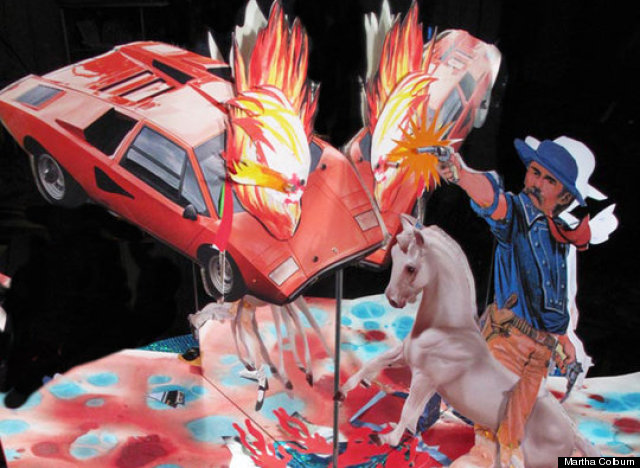Martha Colburn's 8mm animation invites you into a kaleidoscopic puppet show in which pop culture and historical trauma engage in aestheticized warfare. The Pennsylvania born artist is known for her creative use of Super 8 stop motion animations, crafting scenes somewhere between battle and ballet. Paper dolls emerge, multiply, grope, bleed and slip away as with the rhythm of a synchronized swimming routine. The moving collages contain a DIY roughness to them, yet also an unplaceable magic that mystifies their construction.
In Colburn's short film originally made for Performa in 2009 titled, "One And One Is Life," Wonder Woman and a horseback cavalry battle a fleet of flying cars. Against a melodramatic score childhood wonder crashes into futuristic technologies as magic and mechanics go at it. The video is as playful as it is disturbing, dark as hypnotizing. It is kind of like if "Toy Story" cross-pollinated with a Robert Delaunay painting. We asked Colburn some questions about the piece, which was recently released on Paddle 8 TV, .

HP: What is the score for 'One and One is Life' and how did you choose it?
MC: I have worked with the pianist and composer Thollem McDonas for years. I asked to use this piece of his because I heard it as a solid contrast to what was happening in the film. It is a kind of anti-heroic film and an anti-heroic piano piece.
HP: Between Wonder Woman, the cops, the cowboys and the sports cars, a lot of the imagery invokes a youthful American nostalgia. How does the childhood imagination play into this piece?
MC: I was bring together the icons of Futurism, cars and speed and masculinity and setting them into a conflict with the female hero, toys and horses. Horse power over taking the cars...the American Calvary are in fact the Cowboys that you have sited. It does resonate a sense of nostalgia, because the Futurists were all about 'the new- the future', so in my film the toys and the feeling of the past are fighting this idea of the future.
HP: How long did the video take to make? What was your process?
MC: A month or so. It had a quick deadline, which for an animator this is always a challenge. My photo copier had broken down ( a failure of 'future technology' in my studio), and around the same time i came upon four discarded IKEA mirrors on the sidewalk. so i brought these home and when i put them together at different angles I realized I could duplicate my images -- free of a copier and technology.
So in a sense, this became another layer of this film reacting against the Technological marvels that the Futurists were so obsessed with. By slipping the characters, (Wonder Woman, the Calvary, the cars) through the cracks between the mirrors and animating this, the figures appear in a kaleidoscopic form. This process tricks the eye and works with simple means. The characters were suspended on the mirrors by having magnets behind the images so that the paper could appear to be floating.
HP: The violence, with its kaleidoscopic shapes of blood, is aestheticized to look more pleasing than the awkward, fumbling sex scene. Would you agree? Why is this so?
MC: The sex scene is actually fully clothed, I was reading some texts by Mina Loy , that reflected Futurism's values concerning sex and the division of the men and women. In the end of the film there is a moment where the characters perhaps pursue some kind of sexual revelry after the destruction of the cars, but this 'clothed-intercourse' first between the Calvary and Wonder Woman, then White Wonder Woman and Black Wonder Woman do in fact kind of fail to excite like the violence did.
HP: You have said of animation: "it’s making gold out of glitter." What did you mean by that?
MC: Well, I think it was ( at the time) my way of saying that I use simple materials to make complex images and ideas.